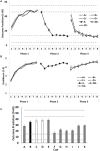Compound Stimulus Presentation Does Not Deepen Extinction in Human Causal Learning
- PMID: 28232809
- PMCID: PMC5298964
- DOI: 10.3389/fpsyg.2017.00120
Compound Stimulus Presentation Does Not Deepen Extinction in Human Causal Learning
Abstract
Models of associative learning have proposed that cue-outcome learning critically depends on the degree of prediction error encountered during training. Two experiments examined the role of error-driven extinction learning in a human causal learning task. Target cues underwent extinction in the presence of additional cues, which differed in the degree to which they predicted the outcome, thereby manipulating outcome expectancy and, in the absence of any change in reinforcement, prediction error. These prediction error manipulations have each been shown to modulate extinction learning in aversive conditioning studies. While both manipulations resulted in increased prediction error during training, neither enhanced extinction in the present human learning task (one manipulation resulted in less extinction at test). The results are discussed with reference to the types of associations that are regulated by prediction error, the types of error terms involved in their regulation, and how these interact with parameters involved in training.
Keywords: Pavlovian conditioning; animal conditioning; extinction; human learning; prediction error.
Figures



References
-
- Culver N. C., Vervliet B., Craske M. G. (2015). Compound extinction using the Rescorla–Wagner model to maximize exposure therapy effects for Anxiety disorders. Clin. Psychol. Sci. 3 335–348. 10.1177/2167702614542103 - DOI
LinkOut - more resources
Full Text Sources
Other Literature Sources

